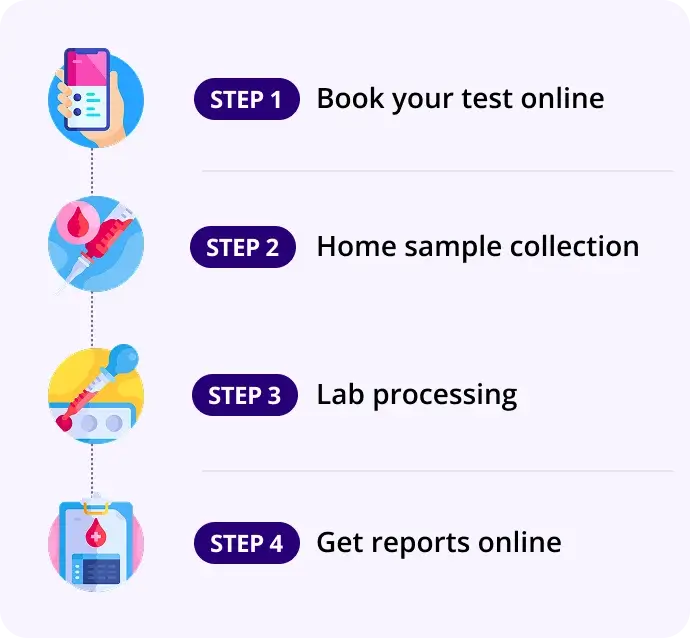Endometrium biopsy - Medium 1-3 c
Report in 300Hrs
At Home
No Fasting Required
Details
It's commonly performed to investigate abnormal uterine bleeding, infertility, or suspected endometrial pathology (like hyperplasia or cancer).
₹399₹1000
60% OFF
🧪 What is an Endometrial Biopsy?
An Endometrial Biopsy is a procedure where a small sample of the endometrial tissue (lining of the uterus) is collected for microscopic examination. It's commonly performed to investigate abnormal uterine bleeding, infertility, or suspected endometrial pathology (like hyperplasia or cancer).
📦 What Does “Medium 1–3 C” Mean?
- “Medium” refers to the volume or amount of tissue obtained during the biopsy — in this case, a moderate amount, enough for reliable histopathologic evaluation.
- “1–3 C” likely refers to Cycle Days 1–3 of the menstrual cycle (early proliferative phase), although in some lab contexts it may be an internal reference to sample quality or categorization. Assuming a clinical context, Cycle Day 1–3 suggests post-menstrual or early proliferative phase of the endometrium.
🩸 Cycle Day 1 is the first day of menstrual bleeding.
❓ Why is an Endometrial Biopsy Done?
To investigate:
- Abnormal uterine bleeding (especially in women >35 years or postmenopausal)
- Infertility
- Amenorrhea or oligomenorrhea
- To confirm ovulation or luteal phase adequacy
- Endometrial hyperplasia or carcinoma
- Monitoring hormone therapy (e.g., tamoxifen)
🔬 Normal Histological Appearance (Days 1–3)
If the biopsy was taken on cycle days 1–3, it typically shows:
Phase | Histological Features |
|---|---|
Menstrual or Early Proliferative | - Breakdown and shedding of functionalis layer |
This phase is normal if the patient is menstruating, and matches the expected timing.
📈 Interpretation of Results
Result | Meaning |
|---|---|
Normal cycling endometrium | Consistent with expected menstrual phase (proliferative/secretory) |
Endometrial hyperplasia | Thickened lining with gland crowding; may progress to cancer |
Endometrial carcinoma | Presence of malignant glandular cells |
Chronic endometritis | Plasma cells, inflammatory infiltrate |
Insufficient sample | May need repeat biopsy |
Atrophic endometrium | Common in postmenopausal women |
🧠 Associated Organs & Conditions
Organ/Condition | Association |
|---|---|
Uterus (endometrium) | Direct tissue examined |
Ovaries | Hormonal control (estrogen/progesterone cycle) |
PCOS | Can lead to unopposed estrogen → hyperplasia |
Endometrial cancer | Especially in postmenopausal bleeding |
Infertility | May show luteal phase defects or endometrial non-receptivity |
🔄 Related / Follow-up Tests
- Transvaginal Ultrasound (TVUS) – To measure endometrial thickness
- Pap smear / Cervical biopsy
- Hormone testing (FSH, LH, Estradiol, Progesterone)
- Hysteroscopy – Direct visualization of uterine cavity
- CA-125 / Tumor markers – If malignancy suspected
- Pelvic MRI – For deeper lesion mapping (if cancer suspected)
📝 Summary
Parameter | Summary |
|---|---|
What | Sampling of endometrial tissue for microscopic examination |
Medium 1–3 C | Moderate tissue collected around Day 1–3 of cycle (early proliferative phase) |
Why | To investigate abnormal bleeding, infertility, or endometrial disease |
Normal Result (Day 1–3) | Menstrual debris or early proliferative glands/stroma |
Abnormal Findings | Hyperplasia, malignancy, chronic inflammation, atrophy |
Next Steps | Imaging, hormone evaluation, further biopsy or hysteroscopy if needed |
How our test process works!

